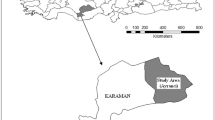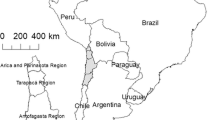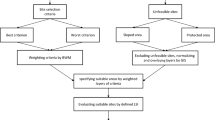Abstract
The ongoing rise in energy consumption imposed serious environmental challenges by using fossil fuels. The use of renewable energy sources is being increasingly explored as a potential answer for achieving sustainable energy production and minimizing adverse environmental effects. In the modern day, photovoltaic (PV) systems are viewed as a possible replacement for fossil fuels as a clean energy source. The installation of solar PV power plants requires vast land and huge investment. Therefore, it is necessary to select a suitable site to achieve maximum efficiency and low cost. A feasible location of photovoltaic (PV) system must consider certain criteria including land restrictions, access to roads, and transmission lines. This study analyzed ten factors grouped into four categories: geographic, technical, economic, and flood susceptibility criterion. The data of each factor is extracted from various governments, United Nation (UN), and non-government organizational bodies. Weights were assigned to ten factors by using a non-linear multi-criteria optimization technique called full consistency method (FUCOM). A geographic information system (GIS) software, ESRI ArcGIS pro, performs the weighted overlay analysis of the ten factors with weighted importance calculated by the above technique. A suitability map is created showing that a total of 2.02% of the country’s area is suitable for PV power plants, which are further divided into five suitability classes. The results highlight the distribution of suitable sites for the construction of solar PV power plant throughout the country. A sensitivity analysis is performed to highlight the impact of the factor on the final suitability map. These findings can promote the future widespread development and application of solar energy resources.









Similar content being viewed by others
Data availability
The data used to support the findings of this study are included within this article. However, the reader may contact the corresponding author for more details on the data.
References
Al Garni HZ, Awasthi A (2017) Solar PV power plant site selection using a GIS-AHP based approach with application in Saudi Arabia. Appl Energy 206:1225–1240. https://doi.org/10.1016/j.apenergy.2017.10.024
Al-Anbar MA, Thameer MY, Al-Ansari N (2018) Landfill site selection by weighted overlay technique: case study of Al-Kufa, Iraq. Sustainability 10(4):999. https://doi.org/10.3390/su10040999
Ali Y et al (2020) Development of a new hybrid multi criteria decision-making method for a car selection scenario. Facta Universitatis; Mech Eng 18(3):357–373. http://casopisi.junis.ni.ac.rs/index.php/FUMechEng/article/view/6195
Al-Rabeeah A, Seres I, Farkas I (2022) Recent improvements of the optical and thermal performance of the parabolic trough solar collector systems. Facta Univ Ser: Mech Eng 20(1):073–094. https://doi.org/10.22190/FUME201106030A
Amjad F, Shah LA (2020) Identification and assessment of sites for solar farms development using GIS and density based clustering technique- A case of Pakistan. Renew Energy 155:761–769. https://doi.org/10.1016/j.renene.2020.03.083
Ayough A, Boshruei S, Khorshidvand B (2022) A new interactive method based on multi-criteria preference degree functions for solar power plant site selection. Renew Energy 195:1165–1173. https://doi.org/10.1016/j.renene.2022.06.087
Baalbaki NH (2020) Optimal site selection for combined renewable energy installations in Lebanon. Doctoral dissertation. https://scholarworks.aub.edu.lb
Badi I, Bouraima MB, Jibril ML (2022) Risk assessment in construction projects using the grey theory. J Engi Manag Syst Eng 1(2):58–66. https://doi.org/10.56578/jemse010203
Barzehkar M, Parnell KE, Dinan NM, Brodie G (2021) Decision support tools for wind and solar farm site selection in Isfahan Province, Iran. Clean Technol Environ Policy 23:1179–1195. https://doi.org/10.1007/s10098-020-01978-w
Bekar N (2022) Energy geopolitics of Turkey In terms of renewable energy sources. Turk J Polit 3(1):37–54. https://dergipark.org.tr/en/pub/tsbder/issue/53350/709200
Biswas S, Pamucar D, Kar S, Sana SS (2021) A new integrated FUCOM–CODAS framework with fermatean fuzzy information for multi-criteria group decision-making. Symmetry 13(12):2430. https://doi.org/10.3390/sym13122430
Bódis K et al (2019) A high-resolution geospatial assessment of the rooftop solar photovoltaic potential in the European Union. Renew Sustain Energy Rev 114:09309. https://doi.org/10.1016/j.rser.2019.109309
Boyacı AÇ, Şişman A (2022) Pandemic hospital site selection: a GIS-based MCDM approach employing Pythagorean fuzzy sets. Environ Sci Pollut Res 29(2):1985–1997. https://doi.org/10.1007/s11356-021-15703-7
Božanić D et al (2021) D numbers – fucom – fuzzy rafsi model for selecting the group of construction machines for enabling mobility. Facta Universitatis; Mech Eng 19(3):447–471. https://doi.org/10.22190/FUME210318047B
Colak HE, Memisoglu T, Gercek Y (2020) Optimal site selection for solar photovoltaic (PV) power plants using GIS and AHP: A case study of Malatya Province, Turkey. Renew Energy 149:565–576. https://doi.org/10.1016/j.renene.2019.12.078
Deveci M, Cali U, Pamucar D (2021) Evaluation of criteria for site selection of solar photovoltaic (PV) projects using fuzzy logarithmic additive estimation of weight coefficients. Energy Rep 7:8805–8824. https://doi.org/10.1016/j.egyr.2021.10.104
Deveci M, Pamucar D, Oguz E (2022) Floating photovoltaic site selection using fuzzy rough numbers based LAAW and RAFSI model. Appl Energy 324:119597. https://doi.org/10.1016/j.apenergy.2022.119597
Deveci M et al (2023) Sustainable E-scooter parking operation in urban areas using fuzzy Dombi based RAFSI model. Sustain Cities Soc 91:104426. https://doi.org/10.1016/j.scs.2023.104426
Devitt DA, Young MH, Pierre JP (2020) Assessing the potential for greater solar development in West Texas, USA. Energy Strat Rev 29:1–10. https://doi.org/10.1016/j.esr.2020.100490
Dhunny A Z et al (2019) Identification of optimal wind, solar and hybrid wind-solar farming sites using fuzzy logic modelling. Energy 188:116056. https://doi.org/10.1016/j.energy.2019.116056
Durmić E et al (2020) Sustainable supplier selection using combined FUCOM – Rough SAW model. Reports in Mech Eng 1(1):34–43. https://doi.org/10.31181/rme200101034c
ESRI (2021) Sentinental 2 10m landuse/landcover. [Online] Available at: https://www.arcgis.com/apps/mapviewer/index.html?layers=cfcb7609de5f478eb7666240902d4d3d. Accessed 1 jun 2022
Everest T, Savaşkan GS, Or A, Özcan H (2022) Suitable site selection by using full consistency method (FUCOM): a case study for maize cultivation in northwest Turkey. Environ Dev Sustain. https://doi.org/10.1007/s10668-022-02787-5
Fahad A, Shah LA (2020) Identification and assessment of sites for solar farms development using GIS and density based clustering technique- A case of Pakistan. Renew Energy 155:761–769. https://doi.org/10.1016/j.renene.2020.03.083
Fillol E et al (2017) Spatiotemporal indicators of solar energy potential in the Guiana Shield using GOES images. Renew Energy 111:11–25. https://doi.org/10.1016/j.renene.2017.03.081
Georgiou A, Skarlatos D (2016) Optimal site selection for sitting a solar park using multi-criteria decision analysis and geographical information systems. Geosci Instrum Method Data Syst 5:321–332
Gokasar I, Pamucar D, Deveci M, Ding W (2023) A novel rough numbers based extended MACBETH method for the prioritization of the connected autonomous vehicles in real-time traffic management. Expert Syst Appl 211:118445. https://doi.org/10.1016/j.eswa.2022.118445
Government of Pakistan (2019) Alternate and renewable energy policy 2019, Islamabad: Ministry of Energy (Power Division)
Government of Pakistan (2021) Pakistan: updated nationally determined contributions 2021. United Nations Framework Convention on Climate Change, Paris
Guaita-Pradas I, Marques-Perez I, Gallego A, Segura B (2019) Analyzing territory for the sustainable development of solar photovoltaic power using GIS databases. Environ Monit Assess 191:1–17. https://doi.org/10.1007/s10661-019-7871-8
Günen MA (2021) A comprehensive framework based on GIS-AHP for the installation of solar PV farms in Kahramanmaraş, Turkey. Renew Energy 178:212–225. https://doi.org/10.1016/j.renene.2021.06.078
Halder B et al (2021) Land suitability investigation for solar power plant using GIS, AHP and multi-criteria decision approach: a case of Megacity Kolkata, West Bengal, India. Sustainability 14(18):11276. https://doi.org/10.3390/su141811276
Hamou S, Zine S, Abdella R (2014) Efficiency of PV module under real working conditions. Energy Procidea 50:553–558. https://doi.org/10.1016/j.egypro.2014.06.067
Hassaan MA, Hassan A, Al-Dashti H (2021) GIS-based suitability analysis for siting solar power plants in Kuwait. Egypt J Remote Sens Space Sci 24(3):453–461. https://doi.org/10.1016/j.ejrs.2020.11.004
Jun D, Tian-tian F, Yi-sheng Y, Yu M (2014) Macro-site selection of wind/solar hybrid power station based on ELECTRE-II. Renew Sustain Energy Rev 35:194–204. https://doi.org/10.1016/j.rser.2014.04.005
Kabeyi MJB, Olanrewaju OA (2022) Sustainable energy transition for renewable and low carbon grid electricity generation and supply. Front Energy Res 9:743114. https://doi.org/10.3389/fenrg.2021.743114
Kalantari S, Kazemipoor H, Movahedi Sobhani F, Hadji Molana SM (2022) A neutrosophical model for optimal sustainable closed-loop supply chain network with considering inflation and carbon emission policies. Decis Mak Appl Manag Eng 5(2):46–77
Khan F, Ali Y (2022) Implementation of the circular supply chain management in the pharmaceutical industry. Environ Dev Sustain 24:13705–13731. https://doi.org/10.1007/s10668-021-02007-6
Khan MR, Ullah K, Khan Q (2023) Multi-attribute decision-making using Archimedean aggregation operator in T-spherical fuzzy environment. Rep Mech Eng 4(1):18–38. https://doi.org/10.31181/rme20031012023k
Kiptum CK, Bouraima MB, Stević Ž, Okemwa S, Birech S, Qiu YJ (2022) Sustainable strategies for the successful operation of the bike-sharing system using an ordinal priority approach. J Eng Manag Syst Eng 1(2):43–50. https://doi.org/10.56578/jemse010201
Kırcalı Ş, Selim S (2021) Site suitability analysis for solar farms using the geographic information system and multi-criteria decision analysis: the case of Antalya, Turkey. Clean Technol Environ Policy 23(4):1233–1250. https://doi.org/10.1007/s10098-020-02018-3
Koc A, Turk S, Şahin G (2019) Multi-criteria of wind-solar site selection problem using a GIS-AHP-based approach with an application in Igdir Province/Turkey. Environ Sci Pollut Res 26(31):32298–32310. https://doi.org/10.1007/s11356-019-06260-1
Kocabaldır C, Yucel MA (2020) GIS-based multi-criteria decision analysis of site selection for photovoltaic power plants in Çanakkale Province. International Journal of Environment and Geoinformatics 7(3):347–355. https://doi.org/10.30897/ijegeo.689570
Labib A, Abdi MR, Hadleigh-Dunn S, Yazdani M (2022) Evidence-based models to support humanitarian operations and crisis management. Decis Mak Appl Manag Eng 5(1):113–134. https://doi.org/10.31181/dmame030222100y
Li Z (2022) Prospects of photovoltaic technology. Engineering. https://doi.org/10.1016/j.eng.2022.07.008
Lindberg O, Birging A, Widén J, Lingfors D (2021) PV park site selection for utility-scale solar guides combining GIS and power flow analysis: a case study on a Swedish municipality. Appl Energy 282:116086. https://doi.org/10.1016/j.apenergy.2020.116086
Lopes FM et al (2018) Short-term forecasts of GHI and DNI for solar energy systems operation: assessment of the ECMWF integrated forecasting system in southern Portugal. Solar Energy 170:14–30. https://doi.org/10.1016/j.solener.2018.05.039
Lowe RJ, Drummond P (2022) Solar, wind and logistic substitution in global energy supply to 2050 – barriers and implications. Renew Sustain Energy Rev 153:111720. https://doi.org/10.1016/j.rser.2021.111720
Majid M, Mir BA (2021) Landfill site selection using GIS based multi criteria evaluation technique. A case study of Srinagar city, India. Environ Challenges 3:00031. https://doi.org/10.1016/j.envc.2021.100031
Milliken L, White T, Fisher MA (2021) Countering Climate change with renewable energy technologies. Federation of American scientists. https://fas.org/reports/sciencepolicy/countering-climate-change-with-renewable-energy-technologies/
Ministry of water resources (2020) Government of Pakistan, ministry of water. [Online] Available at: https://mowr.gov.pk [Accessed 10 july 2022].
Mondino EB, Fabrizio E, Chiabrando R (2015) Site selection of large ground-mounted photovoltaic plants: a GIS decision support system and an application to Italy. Int J Green Energy 5:515–525. https://doi.org/10.1080/15435075.2013.858047
Noorollahi Y et al (2022) A framework for GIS-based site selection and technical potential evaluation of PV solar farm using Fuzzy-Boolean logic and AHP multi-criteria decision-making approach. Renew Energy 186:89–104. https://doi.org/10.1016/j.renene.2021.12.124
Nuhu SK, Manan ZA, Alwi SRW, Reba MNM (2021) Roles of geospatial technology in eco-industrial park site selection: state–of–the-art review. J Clean Prod 309:127361. https://doi.org/10.1016/j.jclepro.2021.127361
Osintsev N, Rakhmangulov A, Baginova V (2021) Evaluation of logistic flows in green supply chains based on the combined DEMATEL-ANP method. Facta Universitatis Series: Mechanical Engineering 19(3):473–498. https://doi.org/10.22190/FUME210505061O
Pamučar D, Stević Ž, Sremac S (2018) A new model for determining weight coefficients of Criteria in MCDM models: full consistency method (FUCOM). Symmetry. https://doi.org/10.3390/sym10090393
Pamucar D et al (2022) Prioritizing transport planning strategies for freight companies towards zero carbon emission using ordinal priority approach. Comput Ind Eng 169:108259. https://doi.org/10.1016/j.cie.2022.108259
Pradas IG, Perez IM, Gallego A, Segura B (2019) Analyzing territory for the sustainable development of solar photovoltaic power using GIS databases. Environ Monit Assess 191:1–17. https://doi.org/10.1007/s10661-019-7871-8
Puška A, Štilić A, Stojanović I (2023) Approach for multi-criteria ranking of Balkan countries based on the index of economic freedom. J Decis Anal Int Comp 3(1):1–14. https://doi.org/10.31181/jdaic10017022023p
Rezaei J (2015) Best-worst multi-criteria decision-making method. Omega 53(49):57. https://doi.org/10.1016/j.omega.2014.11.009
Rigo PD et al (2020) Renewable energy problems: exploring the methods to support the decision-making process. Sustainability 12(23):10195. https://doi.org/10.3390/su122310195
Saaty RW (1987) The analytic hierarchy process—what it is and how it is used. Math Model 9:161. https://doi.org/10.1016/0270-0255(87)90473-8
Sadeghi M, Karimi M (2017) Gis-based solar and wind turbine site selection using multi-criteria analysis: case study Tehran, Iran. Int Arch Photogramm Remote Sens Spatial Inf Sci 42:469–476. https://doi.org/10.5194/isprs-archives-XLII-4-W4-469-2017
Saleheen MZ et al (2021) A target-oriented performance assessment and model development of a grid-connected solar PV (GCPV) system for a commercial building in Malaysia. Renew Energy 171:371–382. https://doi.org/10.1016/j.renene.2021.02.108
Saraswat SK, Yadav SS, Digalwar AK, Kumar G (2021) MCDM and GIS based modelling technique for assessment of solar and wind farm locations in India. Renew Energy 169:865–884. https://doi.org/10.1016/j.renene.2021.01.056
Sessa EB, Castellano M, Ricciolino P (2021) GIS applications in volcano monitoring: the study of seismic swarms at the Campi Flegrei volcanic complex, Italy. Adv Geosci 52:131–144. https://doi.org/10.5194/adgeo-52-131-2021
Settou B et al (2021) A high-resolution geographic information system-analytical hierarchy process-based method for solar PV power plantsite selection: a case study Algeria. Clean Technol Environ Policy 23:219–234. https://doi.org/10.1007/s10098-020-01971-3
Shah SAA et al (2018) Techno-economic analysis of solar PV electricity supply to rural areas of Balochistan, Pakistan. Energies 11(7):1777. https://doi.org/10.3390/en11071777
Sharma A, Singh G (2018) Optimal site selection and efficiency for solar PV power plant. IJARI 6(1):15–26
Solangi YA, Shah SAA, Zameer H, Ikram M (2019) Assessing the solar PV power project site selection in Pakistan: based on AHP-fuzzy VIKOR approach. Environ Sci Pollut Res 26(29):30286–30302. https://doi.org/10.1007/s11356-019-06172-0
Soydan O (2021) Solar power plants site selection for sustainable ecological development in Nigde, Turkey. SN Appl Sci 3(1):41. https://doi.org/10.1007/s42452-020-04112-z
Spyridonidou S, Sismani G, Loukogeorgaki E, Vagiona DG, Ulanovsky H, Madar D (2021) Sustainable spatial energy planning of large-scale wind and PV farms in Israel: a collaborative and participatory planning approach. Energies 14(3):551. https://doi.org/10.3390/en14030551
Tesic D, Bozanic D, Puska A, Milic A, Marinkovic D (2023) Development of the MCDM fuzzy LMAW-grey MARCOS model for selection of a dump truck. Rep Mech Eng 4(1):1–17. https://doi.org/10.31181/rme20008012023t
The world bank group, 2020. Solargis. [Online] Available at: http://globalsolaratlas.info [Accessed 1 June 2022]
Tunc A, Tuncay G, Alacakanat Z, Sevimli FS (2019) GIS based solar power plant site selection using analytical hierarchy process (AHP) in Istanbul, Turkey. The International Archives of the Photogrammetry, Remote Sensing and Spatial Information Sciences XLII-2/W13:1353–1360. https://doi.org/10.5194/isprs-archives-XLII-2-W13-1353-2019
Türk S, Koç A, Şahin G (2021) Multi-criteria of PV solar site selection problem using GIS-intuitionistic fuzzy based approach in Erzurum province/Turkey. Sci Rep 11(1):32298-32310, https://doi.org/10.1038/s41598-021-84257-y
United Nation environmental programe (2022) World database on protected areas. [Online] Available at: www.protectedplanet.net [Accessed 5 july 2022]
Uyan M (2017) Optimal site selection for solar power plants using multi-criteria evaluation: a case study from the Ayranci region in Karaman, Turkey. Clean Technol Environ Policy 19:2231–2244. https://doi.org/10.1007/s10098-017-1405-2
Verma V, Bisht P, Joshi S (2022) Sustainable supply chain systems of food and beverages SMEs: analyzing sustainable performance using structured equation modeling. J Decis Anal Int Comp 2(1):53–68. https://doi.org/10.31181/jdaic10016062022v
Wang S et al (2016) Selecting photovoltaic generation sites in Tibet using remote sensing and geographic analysis. Solar Energy 133:85–93. https://doi.org/10.1016/j.solener.2016.03.069
Wang CN, Nguyen NAT, Dang TT, Bayer J (2021) A two-stage multiple criteria decision making for site selection of solar photovoltaic (PV) power plant: a case study in Taiwan. IEEE 9:75509–75525. https://doi.org/10.1109/access.2021.3081995
worldbank group (2020) Energydata.info. [Online] Available at: https://energydata.info/dataset [Accessed 5 july 2022]
Wu Y et al (2021) Site selection decision framework for photovoltaic hydrogen production project using BWM-CRITIC-MABAC: a case study in Zhangjiakou. J Clean Prod 324:129233. https://doi.org/10.1016/j.jclepro.2021.129233
Yousefi H, Hafeznia H, Yousefi-Sahzabi A (2018) Spatial site selection for solar power plants using a GIS-based Boolean-Fuzzy logic model: a case study of Markazi Province, Iran. Energies 11(7):1648. https://doi.org/10.3390/en11071648
Zambrano-Asanza S, Quiros-Tortos J, Franco JF (2021) Optimal site selection for photovoltaic power plants using a GIS-based multi-criteria decision making and spatial overlay with electric load. Renew Sustain Energy Rev 143:110853. https://doi.org/10.1016/j.rser.2021.110853
Zhang Y, Ren J, Pu Y, Wang P (2020) Solar energy potential assessment: a framework to integrate geographic, technological, and economic indices for a potential analysis. Renew Energy 149:577–586. https://doi.org/10.1016/j.renene.2019.12.071
Zhou B, Chen J, Wu Q, Pamucar D, Wang W, Zhou L (2022) Risk priority evaluation of power transformer parts based on hybrid FMEA framework under hesitant fuzzy environment. Facta Univ Ser: Mech Eng 20(2):399–420. https://doi.org/10.22190/FUME220223013Z
Author information
Authors and Affiliations
Contributions
AK: data processing, analysis and writing. YA: conceptualization, methodology and supervision. DP: supervision on statistical analysis, revision, visualization, and editing.
Corresponding author
Ethics declarations
Consent
All persons who meet authorship criteria are listed as authors, and all authors certify that they have participated sufficiently in the work to take public responsibility for the content, including participation in the concept, design, analysis, writing, or revision of the manuscript. Furthermore, each author certifies that this material or similar material has not been and will not be submitted to or published in any other publication before its appearance in the Environmental Science and Pollution Research.
Ethical approval and consent to participate
Not applicable.
Consent to publish
Not applicable.
Competing interests
The authors declare no competing interests.
Additional information
Responsible Editor: Philippe Garrigues
Publisher's note
Springer Nature remains neutral with regard to jurisdictional claims in published maps and institutional affiliations.
Rights and permissions
Springer Nature or its licensor (e.g. a society or other partner) holds exclusive rights to this article under a publishing agreement with the author(s) or other rightsholder(s); author self-archiving of the accepted manuscript version of this article is solely governed by the terms of such publishing agreement and applicable law.
About this article
Cite this article
Khan, A., Ali, Y. & Pamucar, D. Solar PV power plant site selection using a GIS-based non-linear multi-criteria optimization technique. Environ Sci Pollut Res 30, 57378–57397 (2023). https://doi.org/10.1007/s11356-023-26540-1
Received:
Accepted:
Published:
Issue Date:
DOI: https://doi.org/10.1007/s11356-023-26540-1




